Rice
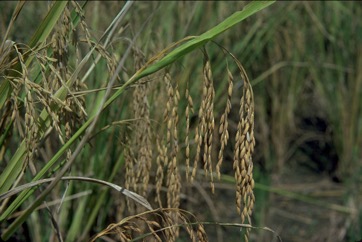
A tropical plant. It grows in tropical and subtropical countries. Plants are grown in both flooded and dryland sites. It will grow over a range of conditions but is normally between sea level and 900 metres altitude in the tropics. Occasionally it is grown up to 1600 m. In Nepal it grows to about 2800 m altitude. It needs a frost free period of over 130 days. It suits hardiness zones 9-12.
Also known as:
Akki, Ari, Arishi, Arisi, Arroz, Arus, Ba, Bak, Beras, Bhat, Bhatta, Biring, Biyyamu, Byeo, Chahai, Chal, Chaval, Chawal, Choka, Dangar, Dao, Dhan, Dhanya, Goyam, Iresi, Kao chow, Kao nyo, Kao, Kome, Mo, Murii, Nasi, Nellu, Nivara, Padi, Pari, Raisi, Reis, Resi, Riso, Riz, Schinkafa, Shinkafa, Sok, Syali, Tandula, Re raiti, Vadlu, Varidhanyamu, Vrihi, Wee, Yimwa
Synonyms
- Oryza glutinosa Lour.
- Oryza sativa cv. italica Alef.
- Oryza sativa subsp. indica Kato
- Oryza sativa var. affinis Korn.
- Oryza sativa var. erythroceros Korn.
- Oryza sativa var. flavoacies Kara-Murza ex Zhuk.
- Oryza sativa var. melanacra Korn.
- Oryza sativa var. suberythroceros Kanevsk
- Oryza sativa var. vulgaris Korn.
- Oryza sativa var. zeravschanica Brches ex Katzaroff, nom. nud. Oryza plena (Prain) Chowdhury
Edible Portion
- Seeds, Cereal, Husks -oil
Where does Rice grow?
Found in: Africa, Angola, Asia, Australia, Bangladesh, Benin, Bhutan, Bolivia, Bougainville, Brazil, Brunei, Burkina Faso, Burundi, Cambodia, Cameroon, Central Africa, Central African Republic, CAR, Central America, Central Asia, Chad, China, Colombia, Comoros, Congo DR, Congo R, Costa Rica, Côte d'Ivoire, Cuba, Dominican Republic, East Africa, East Timor, Ecuador, Egypt, El Salvador, Equatorial-Guinea, Eswatini, Ethiopia, Europe, Fiji, French Guiana, Gabon, Gambia, Ghana, Guam, Guianas, Guinea, Guinée, Guinea-Bissau, Guyana, Haiti, Himalayas, India, Indochina, Indonesia, Iraq, Italy, Ivory Coast, Jamaica, Japan, Kazakhstan, Kenya, Korea, Laos, Liberia, Macedonia, Madagascar, Malawi, Malaysia, Mali, Mauritania, Mauritius, Morocco, Mozambique, Myanmar, Nepal, Nicaragua, Niger, Nigeria, North Africa, North America, Northeastern India, Pacific, Pakistan, Papua New Guinea, PNG, Peru, Philippines, Puerto Rico, Rwanda, SE Asia, Senegal, Seychelles, Sierra Leone, Sikkim, Solomon Islands, Somalia, South Africa, Southern Africa, South America, South Sudan, Spain, Sri Lanka, Sudan, Suriname, Swaziland, Syria, Taiwan, Tajikistan, Tanzania, Thailand, Timor-Leste, Togo, Uganda, Uruguay, United States, Uzbekistan, Vanuatu, Venezuela, Vietnam, West Africa, West Indies, West Timor, Zambia, Zimbabwe
Notes: There are about 20 Oryza species. The B Vitamins are in the outer layers of brown rice.
Status: Although rice is a very popular food, rice is only grown on a small scale in several coastal areas of Papua New Guinea. About 500 million tons of rice are grown worldwide each year. About 5% enters world trade.
Growing Rice
Cultivation: Plants are grown from seed. Seed can be sown direct or in a nursery and transplanted. For dryland crops - 5 to 10 seeds in holes 20 to 25 cm apart. For transplanting 2 or 3 plants as a 20 x 20 cm spacing is suitable. Weed control is a problem in the early stages. Flooding can be used for weed control.
Edible Uses: The grains are boiled and eaten after the husks are removed by pounding and winnowing. It is also made into flour, pasta, cakes, puddings, starch and noodles. Rice paper can be made from the flour. Rice bran mixed with flour can be used for cakes, biscuits, muffins and pancakes. Rice bran is used for pickling vegetables. An oil can be extracted from the husks. The sprouted seeds are eaten in salads. Young seedlings can be used as a vegetable. Rice can be used to make alcohol and milk like drinks. Caution: Alcohol is a cause of cancer.
Production: The glumes are removed to produce husked rice. Polishing removes the integument giving polished rice. Rice development takes 90 to 200 days depending on variety.
Nutrition Info
per 100g edible portion| Edible Part | Energy (kcal) | Protein (g) | Iron (mg) | Vitamin A (ug) | Vitamin c (mg) | Zinc (mg) | % Water |
|---|---|---|---|---|---|---|---|
| Seed white | 366 | 6.4 | 1.9 | - | 0 | - | 11.4 |
| Seed brown | 354 | 7.6 | 2.8 | - | - | - | 13.5 |
| Seed white | 130 | 2.7 | 1.2 | 0 | 0 | 0.49 | 68.4 |
Rice Photos

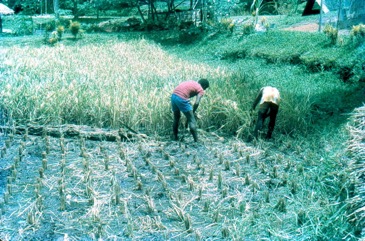
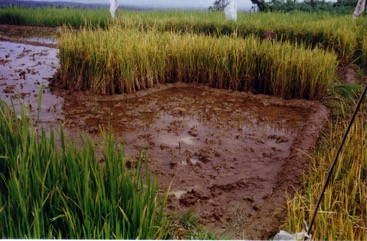
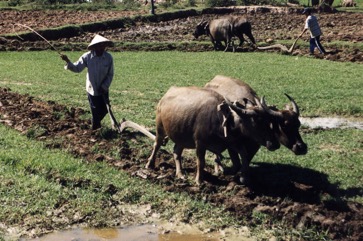
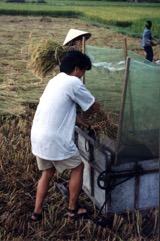
References
Abbiw, D.K., 1990, Useful Plants of Ghana. West African uses of wild and cultivated plants. Intermediate Technology Publications and the Royal Botanic Gardens, Kew. p 24
Ambasta, S.P. (Ed.), 2000, The Useful Plants of India. CSIR India. p 415 (Also as Oryza perennis)
Anderson, E. F., 1993, Plants and people of the Golden Triangle. Dioscorides Press. p 217
Bernholt, H. et al, 2009, Plant species richness and diversity in urban and peri-urban gardens of Niamey, Niger. Agroforestry Systems 77:159-179
Bianchini, F., Corbetta, F., and Pistoia, M., 1975, Fruits of the Earth. Cassell. p 26
Bodkin, F., 1991, Encyclopedia Botanica. Cornstalk publishing, p 747
Bodner, C. C. and Gereau, R. E., 1988, A Contribution to Bontoc Ethnobotany. Economic Botany, 43(2): 307-369
Bremness, L., 1994, Herbs. Collins Eyewitness Handbooks. Harper Collins. p 263
Brickell, C. (Ed.), 1999, The Royal Horticultural Society A-Z Encyclopedia of Garden Plants. Convent Garden Books. p 732
Burkill, H. M., 1985, The useful plants of west tropical Africa, Vol. 2. Kew.
Burkill, I.H., 1966, A Dictionary of the Economic Products of the Malay Peninsula. Ministry of Agriculture and Cooperatives, Kuala Lumpur, Malaysia. Vol 2 (I-Z) p 1620
Chang, T.T., 1979, Rice, in Simmonds N.W.,(ed), Crop Plant Evolution. Longmans. London. p 98
Cobley, L.S. (rev. Steele, W.M.) 2nd Ed., 1976, An Introduction to the Botany of Tropical Crops. Longmans. p 26
Coe, F. G. and Anderson, G. J., 1999, Ethnobotany of the Sumu (Ulwa) of Southeastern Nicaragua and Comparisons with Miskitu Plant Lore. Economic Botany Vol. 53. No. 4. pp. 363-386
Cundall, P., (ed.), 2004, Gardening Australia: flora: the gardener's bible. ABC Books. p 960
Facciola, S., 1998, Cornucopia 2: a Source Book of Edible Plants. Kampong Publications, p 177
Fowler, D. G., 2007, Zambian Plants: Their Vernacular Names and Uses. Kew. p 71
French, B.R., 1986, Food Plants of Papua New Guinea, A Compendium. Asia Pacific Science Foundation p 146
French, B.R., 2010, Food Plants of Solomon Islands. A Compendium. Food Plants International Inc. p 32
Hedrick, U.P., 1919, (Ed.), Sturtevant's edible plants of the world. p 454
Heywood, V.H., Brummitt, R.K., Culham, A., and Seberg, O., 2007, Flowering Plant Families of the World. Royal Botanical Gardens, Kew. p 394
Hussey, B.M.J., Keighery, G.J., Cousens, R.D., Dodd, J., Lloyd, S.G., 1997, Western Weeds. A guide to the weeds of Western Australia. Plant Protection Society of Western Australia. p 60
Hu, Shiu-ying, 2005, Food Plants of China. The Chinese University Press. p 292
Huxley, A. (Ed.), 1977, The Encyclopedia of the Plant Kingdom. Chartweil Books. p 184
Jardin, C., 1970, List of Foods Used In Africa, FAO Nutrition Information Document Series No 2.p 5
Kiple, K.F. & Ornelas, K.C., (eds), 2000, The Cambridge World History of Food. CUP p 1843
Kuo, W. H. J., (Ed.) Taiwan's Ethnobotanical Database (1900-2000), http://tk.agron.ntu.edu.tw/ethnobot/DB1.htm
Lamp, C.A., Forbes, S.J. and Cade, J.W., 1990, Grasses of Temperate Australia. Inkata Press. p 208
Latham, P., 2004, Useful Plants of Bas-Congo province. Salvation Army & DFID p 210
Lazarides, M. & Hince, B., 1993, Handbook of Economic Plants of Australia, CSIRO. p 177
Long, C., 2005, Swaziland's Flora - siSwati names and Uses http://www.sntc.org.sz/flora/
Manandhar, N.P., 2002, Plants and People of Nepal. Timber Press. Portland, Oregon. p 340
Meertens, H.C.C., 2006. Oryza sativa L. [Internet] Record from Protabase. Brink, M. & Belay, G. (Editors). PROTA (Plant Resources of Tropical Africa), Wageningen, Netherlands. < http://database.prota.org/search.htm>. Accessed 20 October 200919 October 2009.
Methodus 197. 1794 (As Oryza perennis)
Miguel, E., et al, 1989, A checklist of the cultivated plants of Cuba. Kulturpflanze 37. 1989, 211-357
Molla, A., Ethiopian Plant Names. http://www.ethiopic.com/aplants.htm
Omawale, 1973, Guyana's edible plants. Guyana University, Georgetown p 102
Paczkowska, G. & Chapman, A.R., 2000, The Western Australian Flora. A Descriptive Catalogue. Western Australian Herbarium. p 111
Phon, P., 2000, Plants used in Cambodia. © Pauline Dy Phon, Phnom Penh, Cambodia. p 481
Plants of Haiti Smithsonian Institute http://botany.si.edu/antilles/West Indies
PROSEA (Plant Resources of South East Asia) handbook Volume 10 Cereals. p 106
Purseglove, J.W., 1972, Tropical Crops. Monocotyledons. Longmans p 163
Rajapaksha, U., 1998, Traditional Food Plants in Sri Lanka. HARTI, Sri Lanka. p 388
Romanowski, N., 2007, Edible Water Gardens. Hyland House. p 100
Rosero-Toro, et al, 2018, Cultural significance of the flora of a tropical dry forest in the Doche vereda (Villavieja, Huila, Colombia). Journal of Ethnobiology and Ethnomedicine (2018) 14:22 p 12
Ruiters-Welcome, A. K., 2019, Food plants of southern Africa. Ph.D. thesis. Univ. of Johannesburg p 89
Segnon, A. C. & Achigan-Dako, E. G., 2014, Comparative analysis of diversity and utilization of edible plants in arid and semi-arid areas in Benin. Journal of Ethnobiology and Ethnomedicine 2014, 10:80
Small, E., 2009, Top 100 Food Plants. The world's most important culinary crops. NRC Research Press. p 464
Solomon, C., 2001, Encyclopedia of Asian Food. New Holland. p 306
Song, M., et al, 2013, Traditional knowledge of wild edible plants in Jeju Island, Korea. Indian Journal of Traditional Knowledge. 12(2) pp 177-194
Sp. pl. 1:333. 1753
Stone, B. C., 1970, The Flora of Guam. A Manual for the Identification of the Vascular Plants of the Island. Micronesica. Journal of the University of Guam. p 184
Sukarya, D. G., (Ed.) 2013, 3,500 Plant Species of the Botanic Gardens of Indonesia. LIPI p 1153
Sukenti, K., et al, 2016, Ethnobotanical study on local cuisine of the Sasak tribe in Lombok Island, Indonesia. Journal of Ethnic Foods. 3( 2016) 189-200 p 194
Swapna, M. M. et al, 2011, A review on the medicinal and edible aspects of aquatic and wetland plants of India. J. Med. Plants Res. 5 (33) pp. 7163-7176
Swaziland's Flora Database http://www.sntc.org.sz/flora
Teron, R. & Borthakur, S. K., 2016, Edible Medicines: An Exploration of Medicinal Plants in Dietary Practices of Karbi Tribal Population of Assam, Northeast India. In Mondal, N. & Sen, J.(Ed.) Nutrition and Health among tribal populations of India. p 154
USDA, ARS, National Genetic Resources Program. Germplasm Resources Information Network - (GRIN). [Online Database] National Germplasm Resources Laboratory, Beltsville, Maryland. Available: www.ars-grin.gov/cgi-bin/npgs/html/econ.pl (10 April 2000)
van Wyk, B., 2005, Food Plants of the World. An illustrated guide. Timber press. p 270
van Wyk, Be, & Gericke, N., 2007, People's plants. A Guide to Useful Plants of Southern Africa. Briza. p 10
Vaughan, J. C. & Geissler, C. A., 2009, The new Oxford Book of Food Plants. Oxford University Press. p 8
Vickery, M.L. and Vickery, B., 1979, Plant Products of Tropical Africa, Macmillan. p 11
Wheeler, J.R.(ed.), 1992, Flora of the Kimberley Region. CALM, Western Australian Herbarium, p 1194
Williams, C.N., Chew, W.Y., and Rajaratnam, J.A., 1989, Tree and Field Crops of the Wetter Regions of the Tropics. Longman, p 149
Williamson, J., 2005, Useful Plants of Malawi. 3rd. Edition. Mdadzi Book Trust. p 180
World Checklist of Useful Plant Species 2020. Royal Botanic Gardens, Kew
Yeshi, K. et al, 2017, Taxonomical Identification of Himalayan Edible Medicinal Plants in Bhutan and the Phenolic Contents and Antioxidant Activity of Selected Plants. TBAP 7 (2) 2017 pp 89 - 106
Zaldivar, M. E., et al, 2002, Species Diversity of Edible Plants Grown in Homegardens of Chibehan Amerindians from Costa Rica. Human Ecology, Vol. 30, No. 3, pp. 301-316